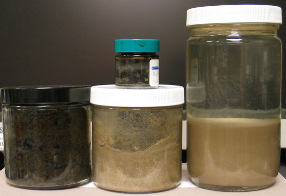Minimizing the Environmental Impacts
At the heart of the Tailings Research Program is the objective to cut the barrels of water required to produce a barrel of bitumen by a factor of 2. It takes 12 to 13 barrels of water to produce a barrel of bitumen, and although the majority of this water is recycled back to the extraction process, a significant portion is lost to the pore spaces of the wet sand and fluid fine tailings that are left over from the extraction process.
Reducing the water lost to the pore spaces in the mineral by a factor of 2 will mean that storage of the fluid fine tailings in the recycle water ponds will be unnecessary since they will no longer behave as a fluid requiring dams and dikes to contain them.

The figure hereof shows 500g of oil sands and resulting bitumen froth product, wet sand tailings and fluid fine tailings topped with recycle water. The current tailings management practice is to contain the fluid fine tailings (and associated recycle water) behind dikes made of the wet sand. The fluid fine tailings have accumulated to approximately 1 billion m3, contained in ponds covering an area in excess of 50 km2.
A (500g) oil sands sample (left) will yield the following: Wet sand tailings (middle), fluid fine tailings and recycle water (right), and a bitumen concentrate (top), half of which will form a third tailings stream, froth treatment tailings.
The Tailings Research Program is an essential part of the development of Canada’s oil sands resource in an environmentally sustainable manner. It has played a significant role in leading the development of new tailings handling technologies that will reduce the barrels of water required to produce a barrel of bitumen.
The commercial implementation of the consolidated tailings process at Suncor Energy was due to research done at CanmetENERGY, and other processes are at various stages of pilot scale demonstration.
Any tailings treatment technology development that increases the amount of recycle water (i.e. decreases the amount of new water required to produce a barrel of bitumen), will have an impact on the water chemistry and quality in the extraction process. As a result, implementation of new water or tailings handling strategies will proceed slowly, and the unique combination of expertise in extraction and tailings behaviour at our facilities will be an important part of that implementation.
Carbon dioxide sequestration potential in oil sands process streams is another prominent area of research we lead. The success of the in-house research program led to a pilot scale demonstration of CO2-CT technology in the fall of 2003 (a joint program between Syncrude, CanmetENERGY, and Canadian Natural Resources Ltd.). Further studies are continuing via CanmetENERGY/University of Alberta oil sands tailings treatment facility, as well as with our in-house research program.
These research directions that serve to enhance the environmental sustainability of surface mined oil sands address the problems associated with both the land disturbance and water requirements to produce a barrel of bitumen. The technologies developed or proved will provide the push needed to ensure that the valuable oil sands resource will be developed with a minimal long term environmental impact.
Some of the tailings management technologies being developed are discussed in detail in our publications.
Managed by CanmetENERGY at the Devon (Alberta) research centre.
Page details
- Date modified: